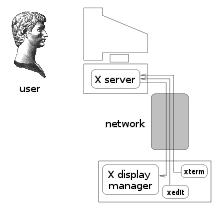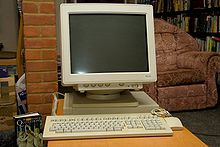| LinuxPlace.net the Linux Place on the Net |
X terminal
By Wikipedia, the free encyclopedia
http://en.wikipedia.org/wiki/X_terminal
In computing, an X terminal is a display/input terminal for X Window System client applications. X terminals enjoyed a period of popularity in the early 1990s when they offered a lower total cost of ownership alternative to a full Unix workstation.
An X terminal runs an X server. (In X, the usage of "client" and "server" is from the viewpoint of the programs: the X server supplies a screen, keyboard, mouse and touchscreen to client applications.) This connects to an X display manager (introduced in X11R3) running on a central machine, using XDMCP (X Display Manager Control Protocol, introduced in X11R4).
Thin clients have somewhat supplanted X terminals in that they are 'fattened' with added flash memory which contains software that duplicates much of the various Microsoft operating systems, thus acquiring the ability to "speak" a range of remote desktop protocols. Due to the existence of free software implementations of multiple protocols, X terminals which do not have this extra flash memory have been commercially obsoleted by more general-purpose thin clients and by low cost PCs running an X server.
Vendors

An X server runs on the X terminal,
connecting to a central computer
running an X display manager.
In this example, client programs
(xterm and xedit) are running
on the same computer
Source: http://en.wikipedia.org/wiki/X_terminal
Published - November 2011
Read all articles at the Linux Place!
All rights reserved © 2011-2024 LinuxPlace.net
